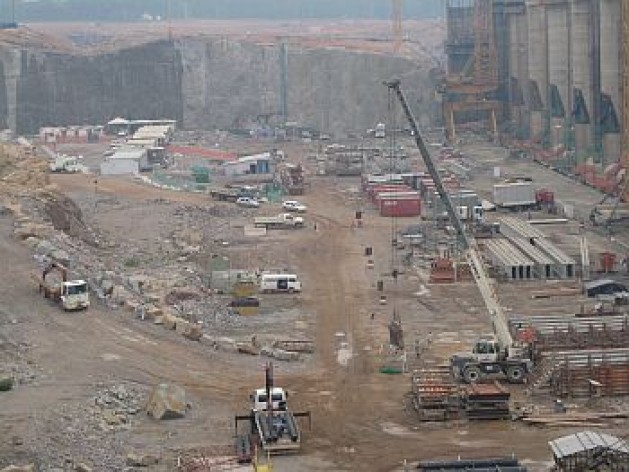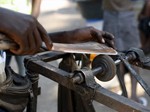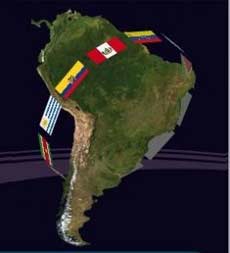Brazil Construction Boom Eases Integration of Haitians | Megaobras facilitan inserción de haitianos
By Mario Osava
IPS
English | Spanish
PORTO VELHO, Brazil – Pierre was in the next-door country of Dominican Republic when the January 2010 earthquake destroyed half of Port-au-Prince and killed at least 200,000 of his fellow Haitians, including his wife and his mother.
His two sons, ages 13 and 14, survived. He left them with friends when he came to Brazil.
But his tragedy did not end there. His younger son later died of hunger. Now, in despair, he sends his surviving son whatever is left over from his wages at his job loading trucks. Meanwhile, he is doing everything he can to bring the boy to his new place in the world, in Porto Velho, the capital of the state of Rondônia in northwest Brazil.
Pierre is one of the hundreds of Haitians who have come to Brazil in search of a new life and an income that makes it possible for them to help their families back home, who are still suffering from the effects of the earthquake, said Marilia Pimentel, who works as a volunteer in a group that supports immigrants.
Porto Velho has become a magnet for immigrants because of the jobs offered by the nearby construction of two huge hydroelectric dams on the Madeira river, one of the main tributaries of the Amazon river, as well as the construction of bridges and the expansion of roads in the area.
The Santo Antonio hydroelectric plant, which will have a capacity to generate 3,150 megawatts, is located seven km outside of the city. It just hired 100 Haitians to work in carpentry, construction, electricity and hydraulics.
But there are nearly 700 Haitians in Porto Velho, and more are arriving every day, said Geraldo Cotinguiba, an anthropologist who, like his wife Pimentel, is helping the new immigrants overcome language and cultural barriers, to facilitate their social insertion and help them find jobs.
The volunteer work of Cotinguiba and Pimentel, who holds a doctorate in linguistics, is carried out in the Catholic parish church in São João Bosco, a centrally-located neighbourhood, where the immigrants are offered meals and Portuguese language courses.
Samuel Dorvilus, a 30-year-old Haitian, also plays an important role at the church. After teaching English and French to Brazilians since he arrived in Porto Velho in March 2011, he is now a translator and interpreter of Haitian creole, and teaches Portuguese to other immigrants.
He was also hired in that capacity by Odebrecht, the company leading construction of the Santo Antonio dam in Porto Velho and numerous other projects around Brazil and in 34 other countries on four continents.
Besides the 100 Haitians hired to work on the Santo Antonio dam, Odebrecht has hired 42 people from that country to help build Teles Pires, another hydroelectric dam 800 km east of Porto Velho, 40 to work on a shipyard building submarines in Itaguaí, near Rio de Janeiro, and 22 for a sugar plant in the central state of Goiás.
The Haitian workers receive the same wages and benefits as the rest of the employees while they receive job training as well as intensive Portuguese language courses, so they can support their families in Haiti and pay off the debts incurred by their long journey to Brazil, the company said.
Odebrecht runs the Acreditar (Believe) programme, which trains local workers in the areas where it has construction projects. Around 70 percent of the nearly 20,000 people working on the Santo Antonio construction site have taken the programme’s courses.
The number of Haitians in Rondônia is small compared to the communities of Bolivians and Peruvians. But they stand out as they have come from a more distant country with a black population that speaks a language much less familiar to Brazilians than Spanish.
“They’re seen as foreigners, not neighbours,”
and they generally speak only creole and French, Pimentel said.
This new wave of immigration is reminiscent of the origins of Porto Velho, in which people from Caribbean nations played a major role.
A century ago, several thousand people from the English-speaking West Indies, collectively referred to here as “Barbadians” because most of them were from Barbados, along with Brazilians and foreigners from other countries in the Americas, Asia and Europe, built the Madeira-Mamoré railroad through inhospitable terrain of swamps and jungle, between what would later be Porto Velho and the border with Bolivia.
Now it is the Haitians who are reviving the connection between Porto Velho and the Caribbean. Fleeing the dire poverty in their country, the poorest in the western hemisphere, they enter Brazil through the Amazon jungle cities of Brasileia and Tabatinga, on the borders with Bolivia and Colombia, respectively, taking advantage of a porous border.
From there they spread out, seeking employment in a wide range of areas, especially the construction industry, which is in the midst of an unprecedented boom in Brazil, of housing as well as energy and transportation infrastructure.
Dorvilus followed the usual route: by plane from Haiti to Ecuador, and from there through Peru and Bolivia to Brasileia.
“I first tried to travel to the United States and later France, but I didn’t get a visa in either case,” he said.
So he decided on Brazil, based on what he had heard about how friendly Brazilians are and the abundance of jobs.
In the case of Brazil, he did get a visa, so he was able to come here legally, he stressed. He then chose Porto Velho because
“it is a quiet place, where you can live in peace”
– a city of 436,000 people without the stress of huge cities like Sao Paulo or Rio de Janeiro.
Dorvilus, who now dreams about bringing his wife and two-year-old son from Haiti, estimates that 15 percent of Haitians in Brazil have not yet found work.
Around 5,000 Haitians have come to Brazil in the last two years, 3,500 of whom are in the state of Amazonas, especially the capital Manaos, according to Cotinguiba and Pimentel.
The couple hopes to set up a centre for studies on immigration along with the Federal University of Rondônia, pointing out that a diverse mix of Amerindians, immigrants, and slaves gave rise to the Brazilian population of today.
Source: IPS
Related:
– Haitians Emigrating to Brazil Undocumented
– ‘Manifesto for Human Rights of Haitian Immigrants in Brazil’ Drafted by Latin Americans
– Total Withdrawal of Brazilian UN Occupation Troops Most Wanted from Roussef
– Haitians Trafficked to Brazil to Work for Problematic French Utility GDF-Suez
Por Mario Osava, enviado especial
IPS
inglés | español
PORTO VELHO, Brasil – El haitiano Pierre estaba en la vecina República Dominicana cuando el terremoto de enero de 2010 destruyó la mitad de Puerto Príncipe y mató a 200.000 compatriotas, entre ellos su esposa y su madre. Sobrevivieron sus dos hijos, de 13 y 14 años, a los que dejó con amigos para emigrar a Brasil.

Central hidroeléctrica Santo Antonio en plena construcción en octubre de 2010 (Crédito: Mario Osava/IPS).
La tragedia de Pierre no terminó ese día. Luego también murió, de hambre, su benjamín. Ahora, en medio de la desesperación, envía todo lo que le sobra de su sueldo de cargador de camiones al hijo que le resta. Mientras, trata de traerlo a su nuevo lugar en el mundo, Porto Velho, la capital del noroccidental estado brasileño de Rondônia.
Este es un caso más entre los haitianos que llegan a Brasil en busca de una nueva vida, en particular tras ingresos que no solo alcancen para sobrevivir sino también para ayudar a sus familias, que siguen sufriendo los daños del terremoto en su país, relató Marilia Pimentel, doctora en lingüística y voluntaria en un grupo de apoyo a inmigrantes.
Porto Velho se convirtió en un punto de atracción por los empleos que ofrece la construcción cercana de dos grandes centrales hidroeléctricas en el río Madeira, uno de los grandes afluentes del Amazonas, además de puentes y la ampliación de carreteras en la zona.
|
La Central Hidroeléctrica de Santo Antonio, que tendrá capacidad para generar 3.150 megavatios a siete kilómetros de esta ciudad, acaba de contratar a 100 haitianos para trabajar en carpintería, albañilería, electricidad e hidráulica.
Pero hay cerca de 700 de esos nuevos inmigrantes en Porto Velho y otros arriban cada día, observó Geraldo Cotinguiba, antropólogo que, como su esposa Pimentel, ayuda a los haitianos a superar la barrera profesional y social que implican una lengua y una cultura distintas.
Ambos profesionales lo hacen en colaboración con la parroquia de São João Bosco, un barrio céntrico, que les ofrece a los inmigrantes alimentación y cursos de portugués.
En ese templo católico es donde también Samuel Dorvilus, haitiano de 30 años, cumple un importante papel. Tras haber enseñado inglés y francés a los brasileños desde que llegó a Porto Velho en marzo de 2011, ahora es traductor de creole (lengua haitiana) y profesor de portugués para sus compatriotas.
En esa condición fue también contratado por Odebrecht, la empresa que lidera la construcción de la represa hidroeléctrica de Santo Antonio en Porto Velho y otros numerosos proyectos dispersos por Brasil y 34 países más en cuatro continentes.
Además de los 100 haitianos contratados para Santo Antonio, Odebrecht también empleó 42 personas del mismo origen para Teles Pires, otra hidroeléctrica que construye a 800 kilómetros al este de Porto Velho, 40 para acondicionar una base en Itaguaí, cerca de Río de Janeiro, para que la armada fabrique submarinos, y 22 más para una unidad azucarera en el central estado de Goiás.
Esos trabajadores reciben un sueldo y beneficios similares a los demás empleados mientras son capacitados profesionalmente y en lengua portuguesa en cursos intensivos, para que de ese modo puedan sostener a sus familias en Haití y pagar las deudas contraídas en el largo viaje hasta Brasil, informó la empresa.
Odebrecht mantiene el Programa Acreditar de formación profesional para la mano de obra local donde actúa. Alrededor de 70 por ciento de los casi 20.000 trabajadores que se desempeñan en Santo Antonio pasaron por esos cursos.
La presencia haitiana en Rondônia es pequeña comparada con las comunidades de bolivianos y peruanos, pero se destaca por llegar de un país lejano, de población negra y lengua menos conocida en Brasil que el español.
“Son extranjeros, no vecinos”,
y en general solo hablan creole y francés, resumió Pimentel.
Esa nueva inmigración recuerda también el nacimiento de Porto Velho, en el que otros caribeños tuvieron gran participación.
Hace 100 años, unos miles de antillanos anglófonos, llamados “barbadianos” porque la mayoría eran de Barbados, junto con brasileños y extranjeros de otro origen, como del resto de América, Asia y Europa, construyeron el ferrocarril Madeira-Mamoré a través de un área inhóspita de pantanos y bosques, entre lo que luego sería Porto Velho y la frontera con Bolivia.
Ahora son los haitianos quienes restablecen ese hilo que une Porto Velho con el Caribe. Huyendo de la miseria en su país, entran a Brasil por las ciudades amazónicas de Brasileia y Tabatinga, en las fronteras con Bolivia y Colombia respectivamente, aprovechando la ausencia de control.
De allí se dispersan, buscando empleo en las más variadas empresas, especialmente en la construcción, que vive un auge sin precedentes en Brasil, tanto de viviendas como de infraestructura energética y de transporte.
Dorvilus cumplió el trayecto usual: en avión de Haití a Ecuador y de allí hasta Brasileia, que exige pasar por Perú y Bolivia.
“Primero intenté viajar a Estados Unidos y luego a Francia, pero no obtuve la visa en ningún caso”, contó.
Optó entonces por Brasil, basado en informaciones sobre el “pueblo acogedor” de ese país y la abundancia de empleos.
Para Brasil, sí logró la visa de ingreso, así que entró legalmente, como subrayó. Eligió luego Porto Velho, porque es un lugar
“tranquilo, donde se puede vivir en paz”,
una ciudad de 436.000 habitantes sin la agitación de grandes metrópolis.
Este inmigrante, que ahora sueña con traer de Haití a su esposa e hijo de dos años, estima que 15 por ciento de sus compatriotas en Brasil aún siguen sin trabajo.
Cerca de 5.000 haitianos llegaron a Brasil en los dos últimos años, 3.500 de los cuales se concentraron en el estado de Amazonas, especialmente en la capital, Manaos, según Cotinguiba y Pimentel.
Ambos pretenden crear un centro de estudios migratorios junto a la estatal Universidad Federal de Rondônia, arguyendo que una diversificada presencia nacional y extranjera ayudó a conformar la población brasileña actual.
Fuente: IPS








Comments
Brazil Construction Boom Eases Integration of Haitians | Megaobras facilitan inserción de haitianos — No Comments